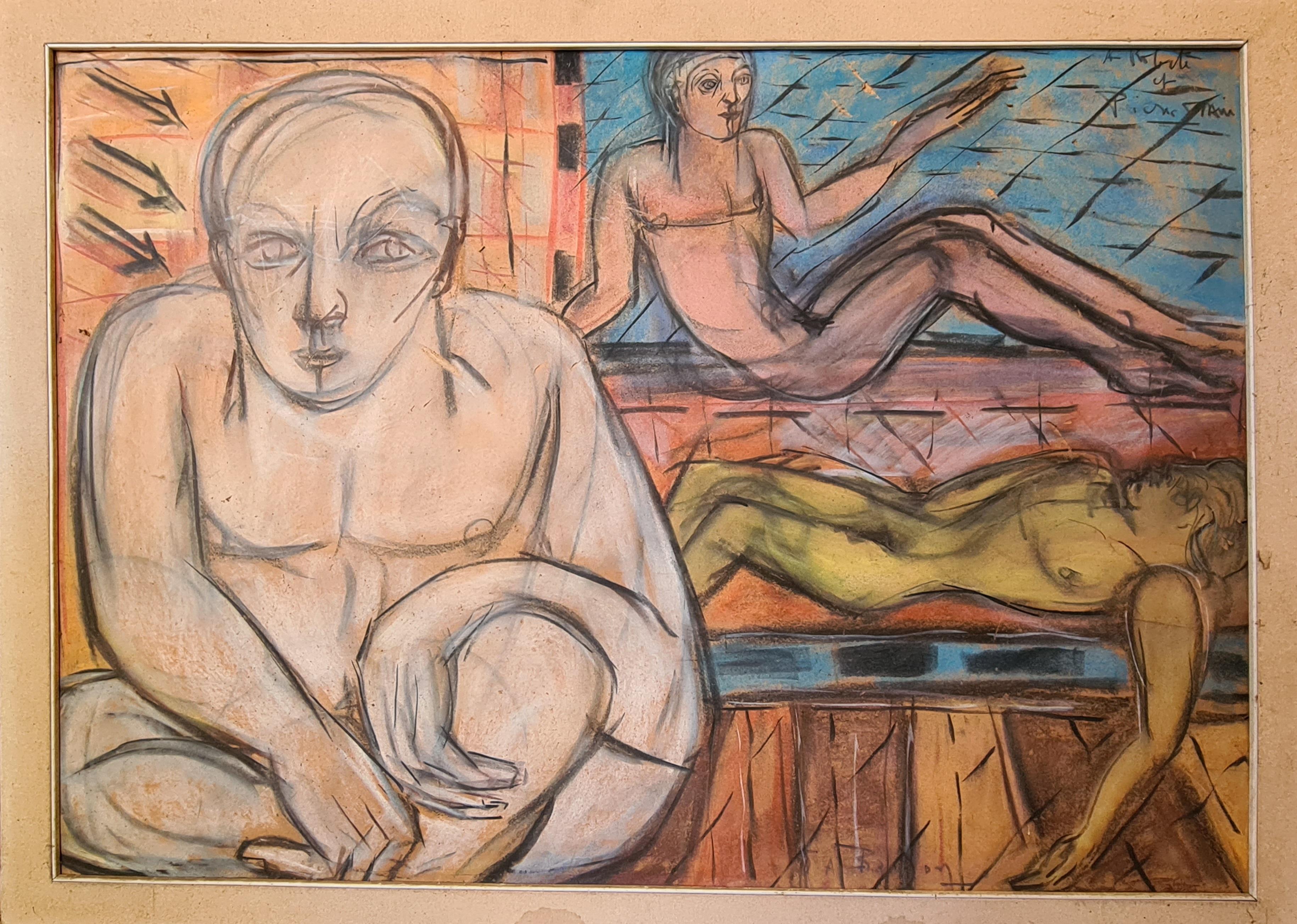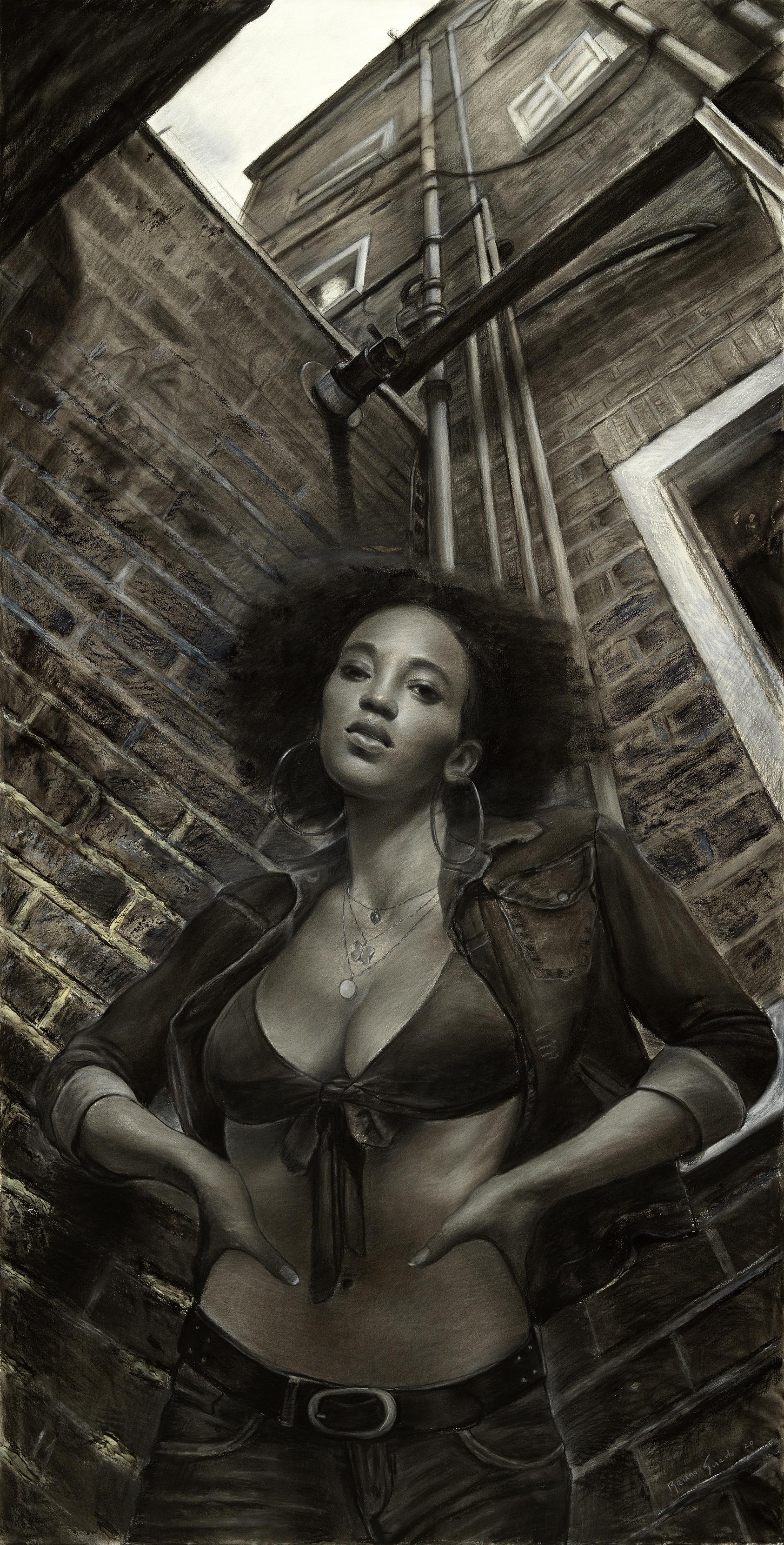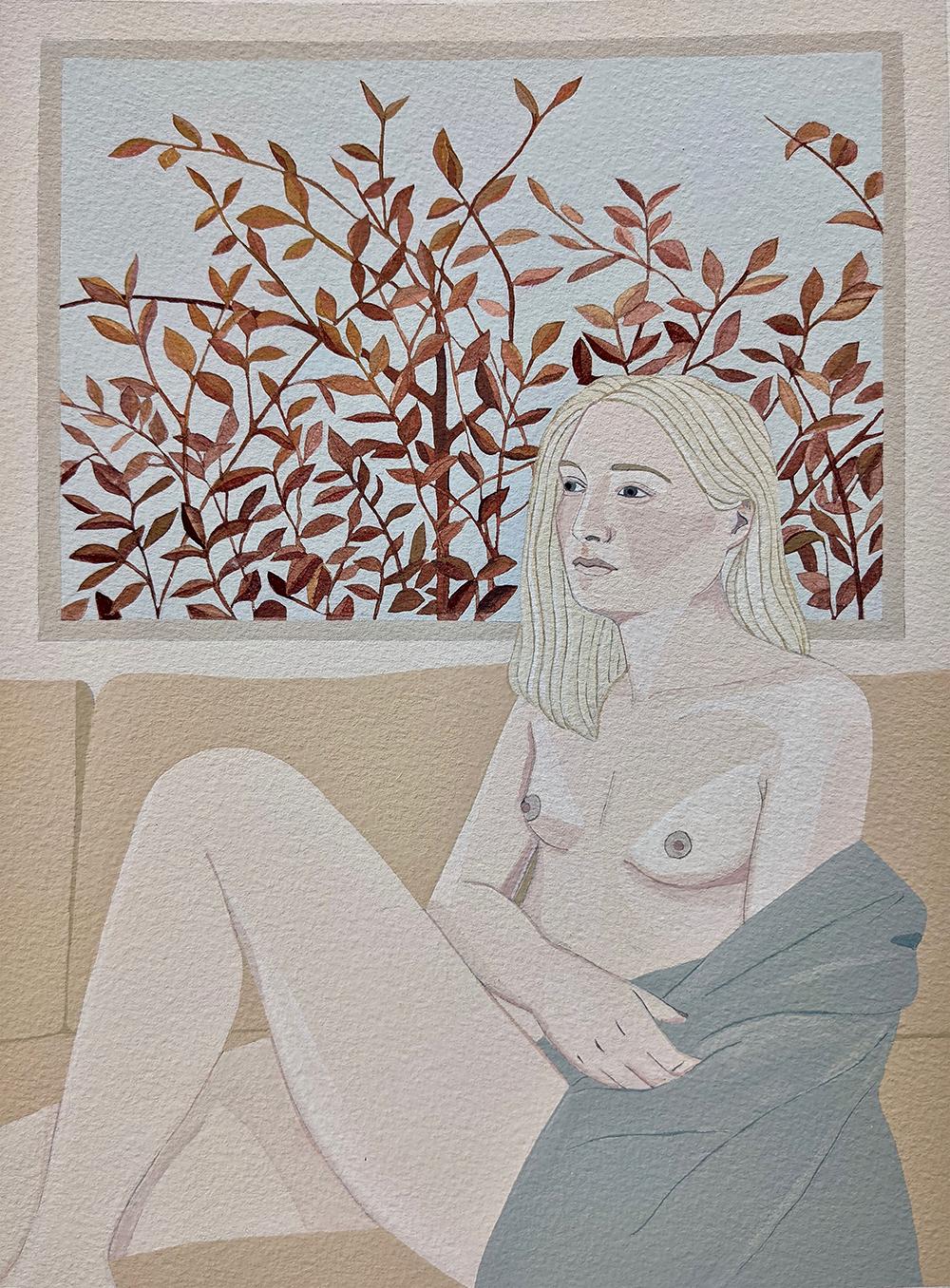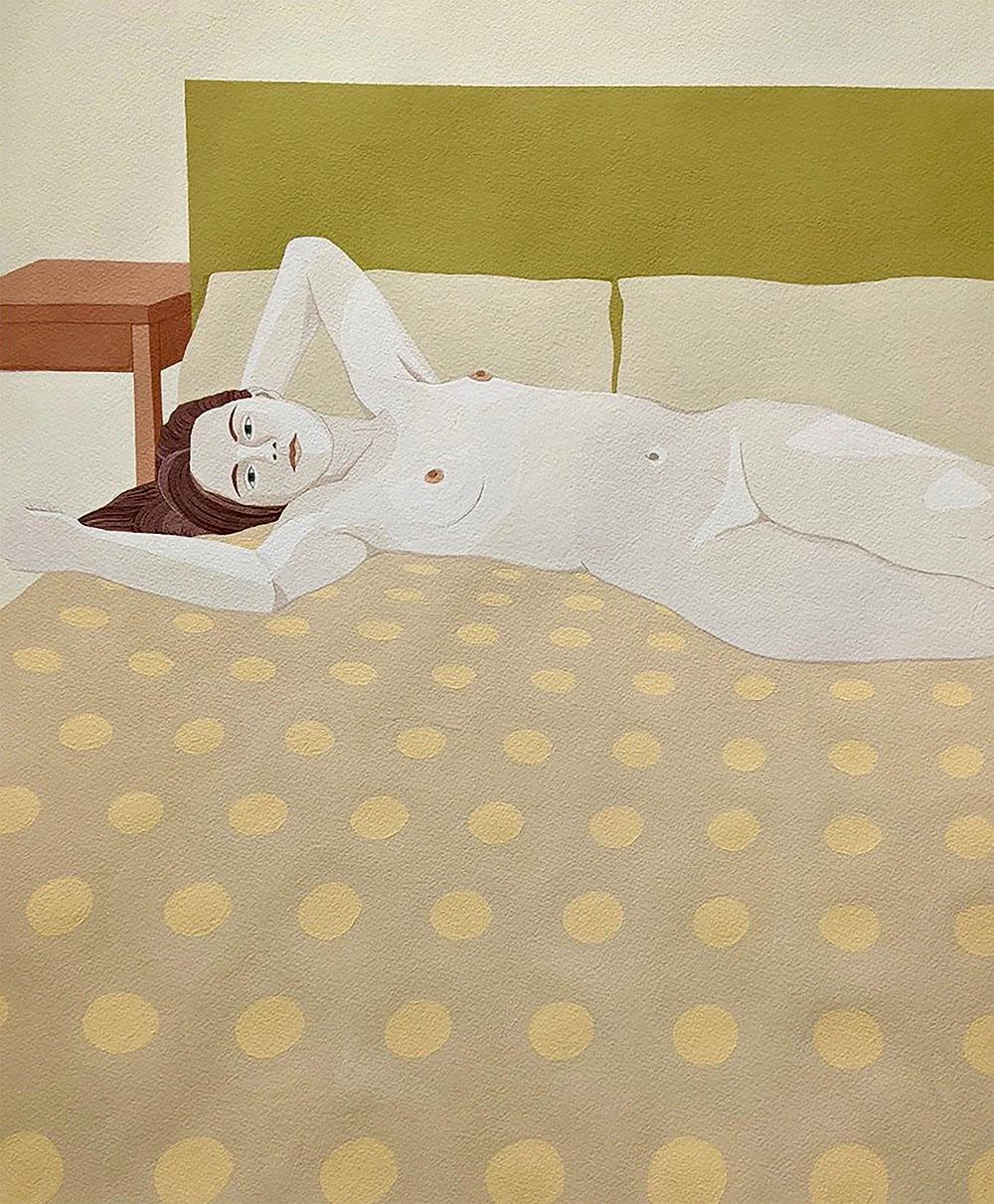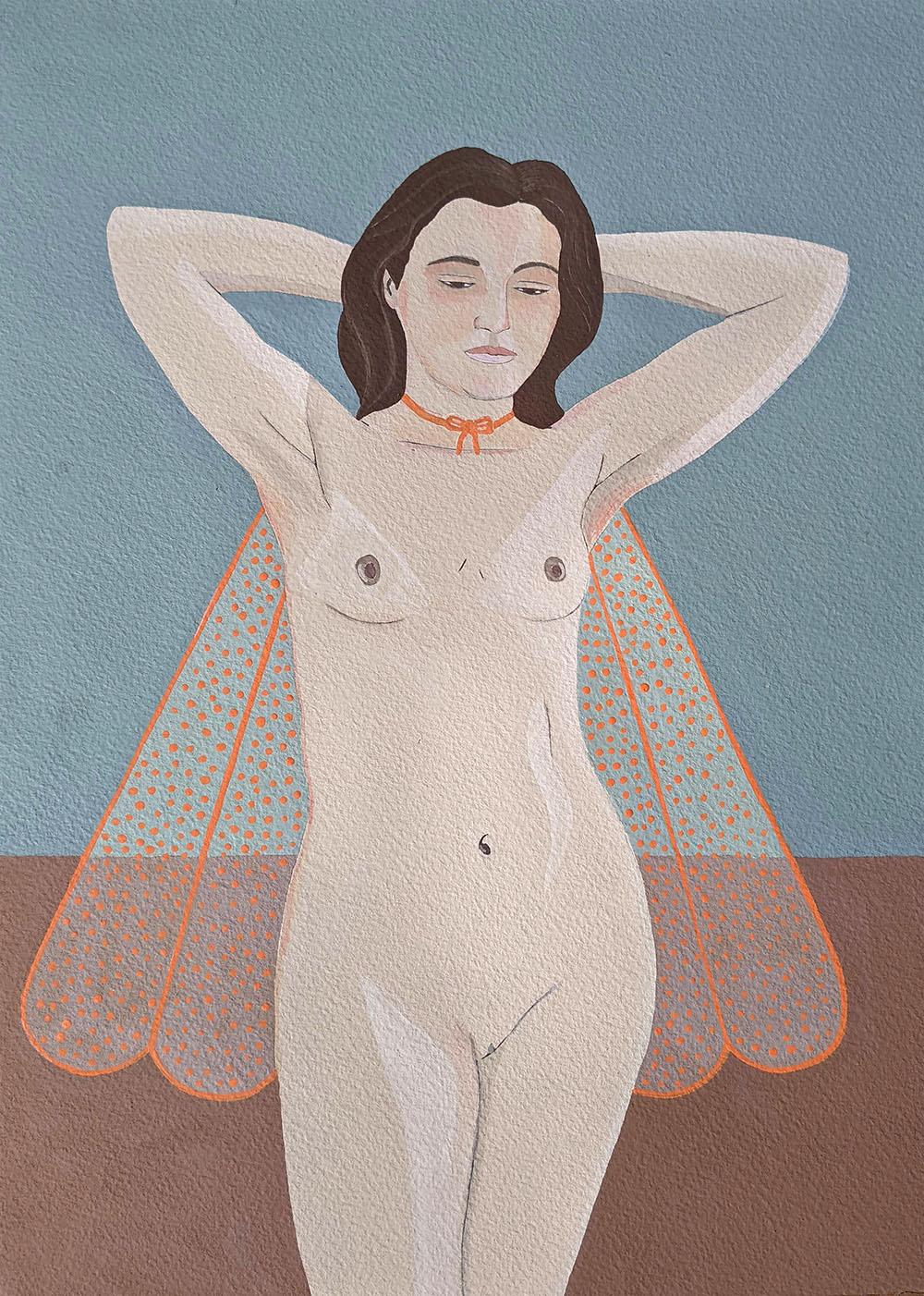Items Similar to Jose antonio, Martes 7 de julio, Figurative painting
Want more images or videos?
Request additional images or videos from the seller
1 of 10
Celso José Castro DazaJose antonio, Martes 7 de julio, Figurative painting2016
2016
About the Item
Jose antonio, Martes 7 de julio 2016, by Celso Castro
Crayon Pastel on archival paper
Image size: 60 H in. x 38 in. W
Unframed
On The back of the painting:
Abstract, 1986
Pencil and pastel on archival paper
Unframed
____________
Undefined by medium, Celso Castro’s works each carry the presence of the artist’s hand through the transparency of their process. Castro’s oeuvre is strongly divided between his photomontage assemblies and watercolor paintings: the prior is marked by the labor-intensive deconstruction of portrait photographs and the latter, by the seemingly frenzied recreation of a past encounter rendered in the drips and scribbles of paint and ink. Both discriminating in what they reveal of the subject, his photomontage and watercolor portraits exude raw sexuality through the combination of Castro’s mark-making and gaze. Celso Castro’s work is a bare-bulb erotic photo foray into the underbelly of Colombia’s drug world. Castro’s labor-intensive, photo-collage works of drug kingpins, smugglers, hitmen, countrymen, street vendors, soldiers, paramilitaries, kidnappers, and pimps pose showing with pride their erect penises to the voyeuristic viewer. They look back at us with a shameless stare. They play the game that moves between vanity and seduction.
Celso Castro was born in Valledupar, Colombia. He has a BFA from the Pratt Institute and has exhibited extensively in Latin America and the U.S.
- Creator:Celso José Castro Daza (1953, Colombian)
- Creation Year:2016
- Dimensions:Height: 60 in (152.4 cm)Width: 38 in (96.52 cm)Depth: 0.1 in (2.54 mm)
- Medium:
- Movement & Style:
- Period:
- Condition:
- Gallery Location:Miami Beach, FL
- Reference Number:1stDibs: LU453313865592
About the Seller
4.9
Recognized Seller
These prestigious sellers are industry leaders and represent the highest echelon for item quality and design.
Established in 2000
1stDibs seller since 2016
225 sales on 1stDibs
Typical response time: 1 hour
- ShippingRetrieving quote...Ships From: Miami Beach, FL
- Return PolicyThis item cannot be returned.
More From This SellerView All
- Pensando & recordando a Luis Caballero, Nude Watercolor on paperBy Celso José Castro DazaLocated in Miami Beach, FL"Pensando & recordando a Luis Caballero" by Celso Castro-Daza From the Duchándome Series Watercolor, pastel, and ink on archival paper Sheet size: 19.5 ...Category
2010s Contemporary Nude Drawings and Watercolors
MaterialsPastel, Archival Ink, Watercolor, Archival Paper
- Poncho viernes 27 de mayo, Figurative DrawingBy Celso José Castro DazaLocated in Miami Beach, FLPoncho viernes 27 de mayo 2016, by Celso Castro Crayon Pastel on archival paper Image size: 59 H in. x 39 in. W Unframed ____________ Undefined by medium, Celso Castro’s works each...Category
1990s Contemporary Nude Drawings and Watercolors
MaterialsPastel, Crayon, Archival Paper
- Duchándome. Nude watercolor on paperBy Celso José Castro DazaLocated in Miami Beach, FLDuchándome, by Celso Castro From the Duchándome Series Watercolor, ink, and pastel archival paper. NUDES 2D Individual size: 19.5 in. H x 13.75 in. W 2018 Drawing on paper is his basic work tool, some are sketches of his surviving works, and others are sketches of moments he documents. ____________ Undefined by medium, Celso Castro’s works each carry the presence of the artist’s hand through the transparency of their process. Castro’s oeuvre is strongly divided between his photomontage assemblies and watercolor paintings: the prior is marked by the labor-intensive deconstruction of portrait photographs and the latter, by the seemingly frenzied recreation of a past encounter rendered in the drips and scribbles of paint and ink. Both discriminating in what they reveal of the subject, his photomontage and watercolor portraits exude raw sexuality through the combination of Castro’s mark-making and gaze. Celso Castro’s work is a bare-bulb erotic photo...Category
2010s Contemporary Nude Drawings and Watercolors
MaterialsPastel, Archival Ink, Watercolor, Archival Paper
- Recanato y compañero, viernes 3 de junio 2016, DrawingBy Celso José Castro DazaLocated in Miami Beach, FLRecanato y compañero, viernes 3 de junio 2016, by Celso Castro Crayon Pastel on archival paper Image size: 59 H in. x 39.5 in. W On the back of the painting: Untitled, 1986 Crayon...Category
1990s Contemporary Nude Drawings and Watercolors
MaterialsArchival Paper, Crayon, Pastel
- Untitled, Figurative DrawingBy Celso José Castro DazaLocated in Miami Beach, FLUntitled, 1986 Diptych Reverse, by Celso Castro Daza Crayon on archival paper Image size: 39.5 H in. x 59 in. W On the back of the painting: Recanato y compañero, viernes 3 de juni...Category
1990s Contemporary Nude Drawings and Watercolors
MaterialsPastel, Crayon, Archival Paper
- Desnudo con medias, sábado 4 de junio, DrawingBy Celso José Castro DazaLocated in Miami Beach, FLDesnudo con medias, sábado 4 de junio, 2016 by Celso Castro-Daza Pastel and Crayon or archival paper Image size: 59 H in. x 40 in. W On the back of the painting: Portrait figurati...Category
1990s Contemporary Nude Drawings and Watercolors
MaterialsPastel, Crayon, Archival Paper
You May Also Like
- Futurist, Novecento Italiano, Mid Century Italian Painting, Figures at the BathsBy Anselmo BucciLocated in Cotignac, FRMid 20th Century Italian Futurist, Novecento Italiano, work on paper, signed bottom right and with dedication top right (see photos). The subject is bathers enjoying the delights of a spa and sauna with colourful tiling to the background. The classical figures languorously positioned in repose but the central 'white' figure in stark contrast. The play on colours gives the work a vibrancy. The drawing is possibly a preparatory sketch for a larger work or mural. A vibrant, exciting and colourful work incorporating the styles of Futurism and the Novecento Italiano movement and with the influences or artists such as Anselmo Bucci, Adami, Jean Helion, Maryan, Achille Funi and Ugo Guidi. Anselmo Bucci was born in 1887 in Fossombrone in the district of Pesaro. Even though he studied Classics, right from a tender age he showed a talent for drawing and, when his parents moved near to Florence, he was taught by the artist Francesco Salvini. In 1904 the family settled in Monza and so the boy was able to study for a year at the Accademia di Belle Arti di Brera, but he did not follow up this educational experience and in 1906 he left Italy for Paris where he came into contact with the Parisian avant-garde, met fellow Italian artists such as Severini and Modigliani, and made friends with Picasso, Utrillo and Apollinaire. In 1907 he showed a painting at the Salon, but these Parisian years were most important for his love of engraving techniques – etching and dry point that enabled him to fully develop his themes characterised by movement. On the outbreak of war in 1915 he returned to Italy and he enlisted in the same battalion as several Futurist artists such as Martinetti, Boccioni, Sant’Elia and Carlo Erba. In 1914 he won the silver medal at the Mostra dell’Incisione (Exhibition of Engravings) at Florence. In 1917 in Paris he published pictures of war scenes entitled “Croquis du Front Italien”. In 1919 he printed twelve lithographs entitled “Finis Austriae” again showing events from the war. At the end of the war he lived between Milan and Paris and he dedicated his time completely to his art with personal exhibitions, exhibiting at all the most important Italian and French shows, in Belgium, Holland and England. In 1922, he established the group “Movimento del Novecento”, (Novecento Italiano), (20th century Movement) a joint venture with the artists Sironi, Funi, Oppi, Malerba, Dudreville and Marussig. Their aim was to return to figurative art in contrast with the growing extremism of the Avant-gardists. In 1925 he worked on the illustration of the first edition of Kipling’s The Jungle Book producing eight dry point plates. In the early 30’s he lived in Bucci, Trieste, where he worked on the furnishing of the steamships for the Trieste Navigazione Libera, at the same time he continued to work on many book illustrations. During the second European war he adapted to being a war artist recording the events of the war as he had done previously. Indeed the engravings depicting battles of the Marines and the Air Force belong to this period. In 1945, following the bombing of his house in Milan, he returned to Monza to his father’s home where he remained until his death. Futurism was an Italian art movement of the early twentieth century that aimed to capture in art the dynamism and energy of the modern world. Futurism was launched by the Italian poet Filippo Tommaso Marinetti in 1909. On 20 February he published his Manifesto of Futurism on the front page of the Paris newspaper Le Figaro. Among modernist movements futurism was exceptionally vehement in its denunciation of the past. This was because in Italy the weight of past culture was felt as particularly oppressive. In the Manifesto, Marinetti asserted that ‘we will free Italy from her innumerable museums which cover her like countless cemeteries’. What the futurists proposed instead was an art that celebrated the modern world of industry and technology: We declare…a new beauty, the beauty of speed. A racing motor car…is more beautiful than the Victory of Samothrace. (A celebrated ancient Greek sculpture in the Louvre museum in Paris.) Futurist painting used elements of neo-impressionism and cubism to create compositions that expressed the idea of the dynamism, the energy and movement, of modern life. Chief artists associated with futurism were Giacomo Balla, Umberto Boccioni, Gino Severini. After the brutality of the first world war, many artists rejected the avant-garde notions of futurism and other pre-war movements, by using more traditional and reassuring approaches, a phenomenon described as the ‘return to order’. Novecento Italiano was founded by Anselmo Bucci (1887–1955), Leonardo Dudreville (1885–1975), Achille Funi, Gian Emilio Malerba (1880–1926), Pietro Marussig, Ubaldo Oppi, and Mario Sironi. Motivated by a post-war "call to order", they were brought together by Lino Pesaro, a gallery owner interested in modern art, and Margherita Sarfatti, a writer and art critic who worked on Italian dictator Benito Mussolini's newspaper, The People of Italy (Il Popolo d'Italia). Sarfatti was also Mussolini's mistress. The movement was officially launched in 1923 at an exhibition in Milan, with Mussolini as one of the speakers. The group was represented at the Venice Biennale of 1924 in a gallery of its own, with the exception of Oppi, who exhibited in a separate gallery. Oppi's defection caused him to be ejected from the group, which subsequently split and was reformed. The new Novecento Italiano staged its first group exhibition in Milan in 1926. Several of the artists were war veterans; Sarfatti had lost a son in the war. The group wished to take on the Italian establishment and create an art associated with the rhetoric of fascism. The artists supported the fascist regime and their work became associated with the state propaganda department, although Mussolini reprimanded Sarfatti for using his name and the name of fascism to promote Novecento. The name of the movement (which means 1900s) was a deliberate reference to great periods of Italian art in the past, the Quattrocento and Cinquecento (1400s and 1500s). The group rejected European avant garde art and wished to revive the tradition of large format history painting in the classical manner. It lacked a precise artistic programme and included artists of different styles and temperament, for example, Carrà and Marini. It aimed to promote a renewed yet traditional Italian art. Sironi said, “if we look at the painters of the second half of the 19th century, we find that only the revolutionary were great and that the greatest were the most revolutionary”; the artists of Novecento Italiano “would not imitate the world created by God but would be inspired by it”. Despite official patronage, Novecento art did not always have an easy ride in Fascist Italy. Mussolini was personally uninterested in art and divided official support among various groups so as to keep artists on the side of the regime. Opening the exhibition of Novecento art in 1923 he declared that “it is far from my idea to encourage anything like a state art. Art belongs to the domain of the individual. The state has only one duty: not to undermine art, to provide humane conditions for artists, to encourage them from the artistic and national point of view." The movement was in competition with other pro-Fascist movements, especially Futurism and the regionalist Strapaese movement. Novecento Italiano also met outright opposition. Achille Starace, the General Secretary of the Fascist Party, attacked it in the Fascist daily press and there was virulent criticism of its “un-Italian" qualities by artists and critics. In the 1930s, a group of professors and students at the Accademia di Brera established an opposition group to Novecento Italiano. Among them was the director of the academy Aldo Carpi, and students Afro, Aldo Badoli, Aldo Bergolli, Renato Birolli, Bruno Cassinari, Cherchi, Alfredo Chighine, Grosso, Renato Guttuso, Dino Lanaro, Giuseppe Migneco, Mantica, Ennio Morlotti, Aligi Sassu, Ernesto Treccani, Italo Valenti, and Emilio Vedova (and later Giuseppe Ajmone...Category
Mid-20th Century Futurist Figurative Paintings
MaterialsCrayon, Pastel, Pencil, Paper
- The Gangway of Justice, Woman Backed into a Corner, Life-Sized Charcoal on PaperBy Bruno SurdoLocated in Chicago, ILDuring the Capone era, dark and narrow passageways became escape routes for those evading the law or other gang members, thus the Chicago term “gangway” was born. Even the police were afraid to enter gangways alone. Bruno has taken that information and created this very provocative piece entitled "The Gangway of Justice" where we see a beautiful black woman...Category
21st Century and Contemporary Contemporary Figurative Paintings
MaterialsCharcoal, Panel, Archival Paper
- Under the Red Leaves gouache painting of female nude, pastel colors, white frameBy Ellen Von WiegandLocated in Dallas, TXBeautiful original gouache paintings on Arches watercolour paper by Ellen Von Wiegand are framed in white, all archival materials, and ready to hang. "Under the Red Leaves" is a gorg...Category
2010s Contemporary Figurative Paintings
MaterialsGouache, Archival Paper
- The Sun Dazzled the House with Light, gouache painting of female nude on yellowBy Ellen Von WiegandLocated in Dallas, TXBeautiful original gouache paintings on Arches watercolour paper by Ellen Von Wiegand are float mounted and framed in white, all archival materials, and ready to hang. "The Sun Dazzl...Category
2010s Contemporary Figurative Paintings
MaterialsGouache, Archival Paper
- Fitted Wings, gouache painting of female nude with wings, blue background, frameBy Ellen Von WiegandLocated in Dallas, TXBeautiful original gouache paintings on Arches watercolour paper by Ellen Von Wiegand are float mounted and framed in white, all archival materials, and ready to hang. "Fitted Wings"...Category
2010s Contemporary Figurative Paintings
MaterialsGouache, Archival Paper
- Energy Worker, bright colorful swirling patterns mystical yoga Wild WomanBy Janet MorganLocated in Brooklyn, NYThis painting is in a series called the Wild Woman which is also printed in a pocket sized book. Watercolor, mixed media, using resists. Janet Morgan’s...Category
2010s Expressionist Nude Drawings and Watercolors
MaterialsMixed Media, Watercolor, Archival Paper
Recently Viewed
View AllMore Ways To Browse
Small Oil Painting Dutch
Catholic Cardinal Oil Painting
Famous Jerusalem Oil Painters
Aaron Bushnell
Woke Art
First Day Of Issue Stamps
Artist Giovanni Boldini
Jacqueline Williams
Statue Painting
Oil Painting Child On Beach
Banksy 3d
Ron King
Marcia Cross
Claret Poster
Edouard Francois Zier
Formula 1 Oil
Mirror Louis Cv
J E Costigan
